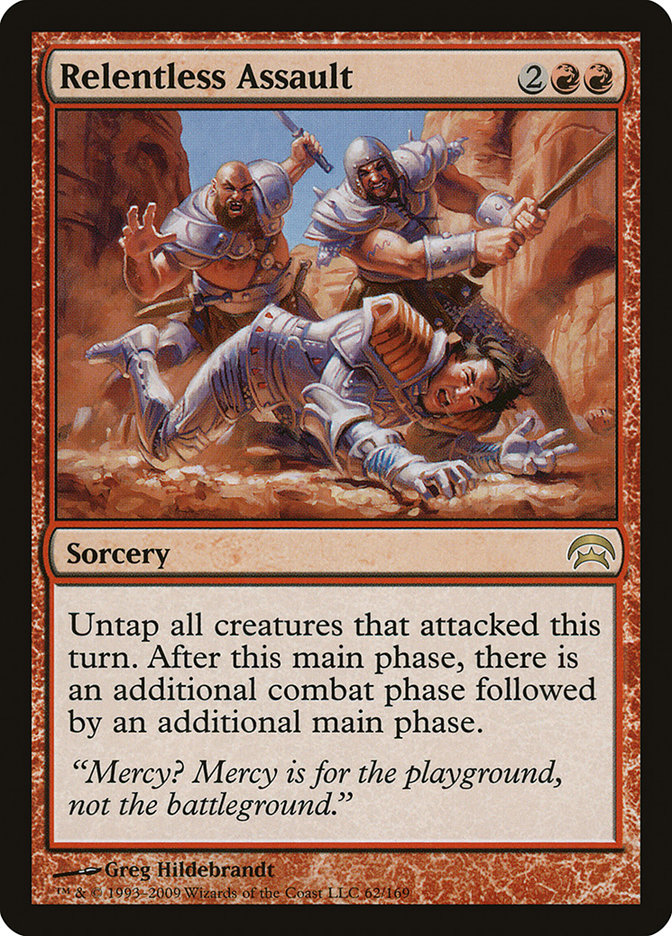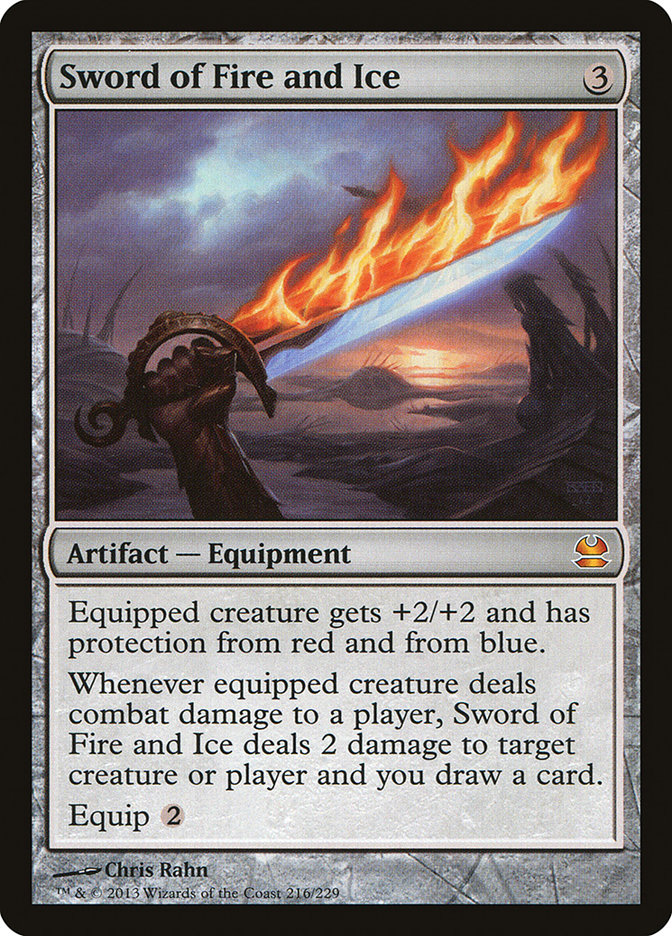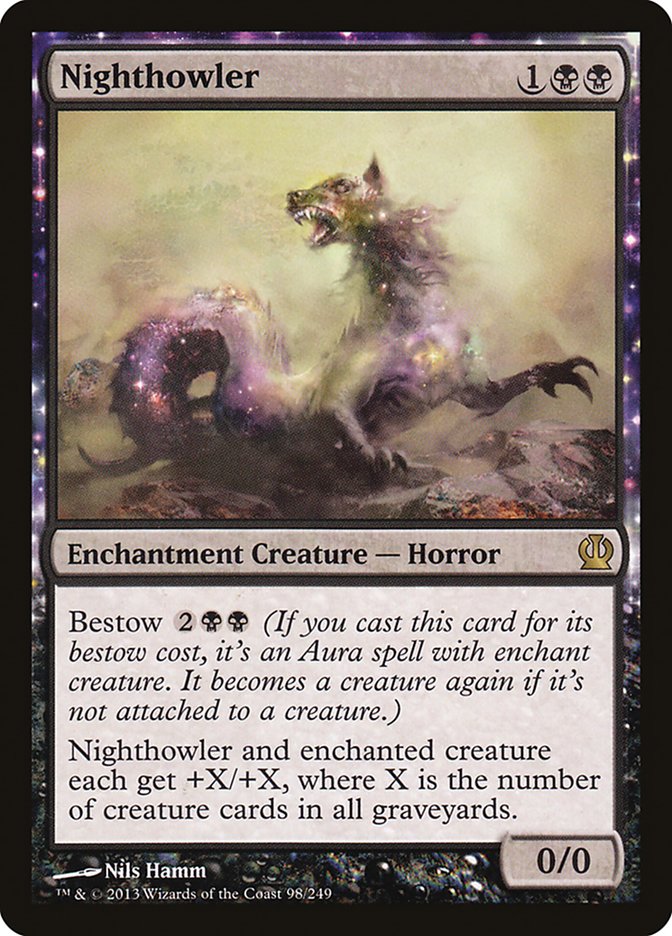Welcome to one of the new features I’m hoping to regularly bring you here in the finest web site in all of Magic, the Players’ Guide Series. The PG is a
kind of primer and idea base for building a deck around a particular Commander: how to open up its strengths and cover up its weaknesses. I’ve done a few
similar pieces, but they’ve focuses on my specific decks. Here, I’d like to open the field far broader. I’m going to offer the latest version of my build
as the end piece, but hopefully I’ll point you off in several other directions as well.
THE BASICS
Thraximundar is a moderately expensive Grixis commander. Haste is a powerful ability on a commander, especially if you’re playing in an environment with
frequent Wrath of God effects. His combat-triggered abilities point you immediately to the combat step and killing with commander damage. The first
triggered ability helps clear the way. The second triggered ability is likely to pile up the counters on him far more quickly. Plus, it’s not just a combat
ability. Any time a player sacrifices a creature, Thraximundar gets a counter. If you take advantage of it, he can be quite large in short order.
Thraximundar has two major weaknesses. The first is that he has no native evasion ability. Sure, his first ability will remove a single chump blocker, but
he can’t natively get around an army. The second is that he is expensive (appropriately-priced for what he does, but nonetheless expensive). Grixis isn’t
particularly good at piles of mana, so whichever direction you go, your build will have to be very tight. His high cost also means that you’re going to
need to spend early turns doing things which will keep you alive and in a reasonable board state. No matter which way you go, you’ll have to prepare the
way for Thraximundar to arrive.
HOW DOES IT WIN?
Thraximundar wins by attacking. As we’ll see in the three directions below, the environment for those attacks may change as well as exactly who you attack
with, but Thraximundar must generally turn sideways in order to send you to victory (although you might enjoy a two-kills/one-turn play with Fling).
HOW DOES IT LOSE?
Two primary conditions exist for Thraximundar losing: the inability to attack and the inability to recast. Inability to attack includes not having evasion,
defenders having too many chump blockers, defenders having creatures that will kill Thraximundar if they block (Acidic Slime is one of the best “life gain”
cards out there), and tap-down situations like with Frost Titan and Meekstone. If Thraximundar gets killed a few times, recasting him can get
cost-prohibitive since he already starts at seven mana.
DIRECTION 1: Focusing on the Combat Step
This build leads you toward ensuring that you simply get combat steps and Thraximundar is there to attack in all or most of them. This is the trickiest
build because you want to always be attacking. You want to give your opponents a choice of damnations: get killed by Thraximundar or get killed by your
other creatures. This involves starting early and never letting up. Thraximundar showing up is the ” Oh, they have a Cave Troll” moment.
Getting your creatures through the combat lines involves either having evasion abilities or not letting them block. Archetype of Aggression, Archetype of
Finality, and Archetype of Imagination are all reasonable choices to make your combat team better than everyone else’s. You can also simply go the “can’t
block” route with cards like Bedlam or its weak cousin Dirge of Dread. There are quite a few cards that make individual creatures unable to block, such as
Bola Warrior (which could set up some kind of reanimation sub-theme), Chandra, Pyromaster, Fervant Cathar, Crossway Vampire, and more. Hero of Oxid Ridge
pushes the chumpiest of chump blockers out of the way. Of course, you could set up some crazy Conspiracy (naming Warrior) and Boldwyr Intimidator
tomfoolery as well.
The other route here is to take your opponents’ creatures out of the equation. Obviously, Plague Wind, In Garruk’s Wake, and Overwhelming Forces work, but
are super-expensive. For more reasonable options, we can look toward Cryptic Command, Sleep, and Turnabout. Frost Titan, Dungeon Geists, Giant Oyster, Sand
Squid, and Somnophore can keep the most annoying creatures tapped down, which also yields some defensive benefits. The king of all the tapping ideas is
Opposition.
Traditionally used with white or green, which are pretty good at creating creatures, Opposition can work extremely well in Grixis. There are numerous
creature-creators to fuel the tapping. My favorite has to be Endrek Sahr, Master Breeder. Since you don’t want to lose Endrek Sahr, you just slam the
thrulls into someone since you’ll make more anyway. You can eliminate the problem by playing the aforementioned Conspiracy, setting it to anything other
than thrull. Goblin Assault provides a free creature each turn, and if you tap it with Opposition, you don’t have to attack with it. Just be careful that
you’re not unintentionally throwing other goblins into the mix. Opposition also gives you a good reason to play inspired cards. Aerie Worshippers, Forlorn
Pseudamma, and Satyr Nyx-Smith help you make more tapping fuel. Fellhide Spellbinder has an inexpensive triggered ability which can pay huge dividends,
Arbiter of the Ideal can put things onto the battlefield for free, and King Macar, the Gold-Cursed will help you clear the path for the attack.
Focusing on the combat step can also mean getting more than one per turn. Aggravated Assault, Fury of the Horde, Hellkite Charger, Relentless Assault, and
World at War are all ways of simply getting another combat. My favorite may be Breath of Fury. It might take a little setup, but it’s a non-infinite mana
way of getting more combat steps than you’ll know what to do with. Combined with Grave Pact or Dictate of Erebos, it can further whittle down any defenses.
Note that it’s a sacrifice with Breath of Fury, so it also makes Thraximundar bigger.
DIRECTION 2: Surrendering to Voltron
Far more narrowly-focused than Direction 1, the Voltron-style build cares only about making a monster out of Thraximundar and getting him to attack.
Traditionally, it’s equipment that makes the Voltron commander, and you have copious choices. Sword of Fire and Ice and Sword of Light and Shadow are the
old-school options. The former deals some damage and draws cards (remember that if you absolutely have to draw the card, don’t target something that might
not be around with the triggered ability resolves; because it’s the only target, the ability will be countered on resolution if the target is illegal or
gone, meaning the whole ability is countered-to be safe, target a player). The latter’s life gain is fine, but the star-maker portion of it is putting a
creature back into your hand. If you’re using your own sacrifice outlets to get them there in the first place, you’ll be making Thraximundar larger. Sword
of Feast and Famine is one of the ways to get some more mileage out of your lands in a deck that doesn’t accelerate its mana too much. Sword of War and
Peace can put a big hurt on someone if they have a full grip, but since you’re trying to Generalissimo them anyway, it’s less significant. You could go
with the whole, Sword of Kaldra, Shield of Kaldra, and Helm of Kaldra set, but you might find it cheaper (and again, in Thraximundar decks, mana is
something you’ll want to pay a great deal of attention to) to just run with Darksteel Plate. Argentum Armor will help you clear the board of things,
although it’s straight destruction, not sacrifice. There aren’t any equipment cards that take advantage of the sacrifice mechanic. Batterskull is a fine
choice, netting you some life as well as dealing out damage, and Bonehoard can result in Thraximundar one-shotting someone reasonably easily.
There are fewer exciting auras than equipment but still some to consider. A few of the bestow cards are quite good, Nighthowler probably being the most
deadly. Flitterstep Eidolon, Herald of Torment, and Purphorous’s Emissary all have their uses. Demonic Appetite is cheap and takes advantage of the
sacrifice mechanic (but it means having to have other creatures which can lead you to getting blown out). Because Thraximundar already gets +1/+1 counters,
Ordeal of Erebos, Ordeal of Purphorous, and Ordeal of Thassa all work quickly, the latter being the most exciting. The two others from the Theros block
which deserve some merit are Aqueous Form and Stratus Walk. Unblockable Thraximundar is a beating. Stratus Walk replaces itself and provides evasion.
Making Thraximundar unblockable is a final piece to the Voltron puzzle. Amphin Pathmage from M15 will get the job done, as well as Rogue’s Passage.
Cephalid Pathmage does double duty in making Thraximundar unblockable and plussing him up due to the sacrifice. Distortion Strike has rebound, so you can
do it on consecutive turns for the low cost of one blue mana. Glaring Spotlight is the Hidden Gem of the day. It lets you kill stuff that you might
otherwise not be able to and eventually gets your commander safely into the killing zone. Neurok Invisimancer is repeatable with some blink or sacrifice
and regrowth effects. If you want to go the snow route, there’s Rime Transformation. Teleportal is an overload spell that works cheaply in the Voltron
build and might even be worthwhile in Direction 1. No discussion of unblockable would be complete without the outstanding Thassa, God of the Sea. For very
little mana, she can scry you into the equipment you want and then make sure Thraximundar connects. The techiest way to make your creatures (nearly)
unblockable is Sun Quan, Lord of Wu. Mount them up! [Horse noises!]
The extra combat step(s) cards also work in your Voltron-style build (although I’d probably forget about Breath of Fury). If Thraximundar is large enough,
you won’t need too many combat steps to take down the whole table.
DIRECTION 3: The Art of Creative Destruction
Direction 3 is what I took when I built my current iteration of the deck. It makes use of the commander as a serious threat but is still capable of
functioning without it. Creative destruction is an economic theory (that I know about
because I saw it on an episode of the best broadcast television show ever, The West Wing)
involving tearing down to build back up. That’s what we do in this deck’s idea. We completely leverage the sacrifice mechanic to build an incremental board
state advantage, leading to a kind of inevitability regarding Thraximundar. It reuses inexpensive things like Bone Shredder and Fleshbag Marauder to keep
opponents in check. I’ve found as I play it that the Thrax threat leads people to ignore some of the other threats in the deck. My version plays a few
cards like Backlash, Rakdos Charm, Twincast, and Wild Ricochet simply because I want to play them. If you want to move all in on the theme, adding another
sacrifice outlet or two-Altar of Dementia and Goblin Bombardment come to mind-is probably the way to go. Syphon Flesh is also a fine choice. I’m
particularly happy with the choice of Minion Reflector because you can get a great deal of mileage out of creatures with enters-the-battlefield abilities
for very little mana, as well as making inexpensive double usage of the evoke creatures. Being able to bring them back with Oversold Cemetery and Dawn of
the Dead leads me to think that Corpse Dance (which was in a previous version) is a powerful choice, especially with those sacrifice outlets. I am also
strongly considering putting Ascendant Evincar back in to help with swarms of small green, white, and red creatures (blue too, but I haven’t experienced
too many decks that run a horde of one toughness creatures). One of the other great uses of evoke creatures is with Attrition. Evoke is a triggered
ability, so when it goes on the stack, you still have the opportunity to sacrifice the creature to Attrition in order to get extra mileage out of it. Sneak
Attack has also been a powerhouse, mostly in the way of combat tricks (get a trigger, do a thing, sacrifice it to Attrition) as opposed to just sneaking a
creature in at end of turn (which occasionally also works-especially when you do it with Deadeye Navigator). Diamond Valley and High Market also work with
evoke and Sneak Attack tricks in order to help get some more mileage out of creatures.
Your opportunity to use the barest bones of this idea is expansive. There are plenty of enters-the-battlefield and leaves-the-battlefield trigger creatures
(like Nevermaker, and my personal favorite, Slithermuse), persist creatures, and whatnot. I haven’t even explored any of the Theros block gods. It seems
like all of them except Phenax, God of Deception, could have a home in the deck. If you have the cash, Tabernacle at Pendrell Vale can end up having
opponents with nasty choices. You can even simply tighten up my deck, swapping out janky cards like Breaking//Entering, Backlash, and Hibernation for more
on-target cards.
SUMMARY
Thraximundar is a build-around commander who gives you multiple directions to choose from. You might consider a variant on the Voltron style where you
don’t have that much to buff up Thraximundar, you just play a heavy control element, clearing the way for your one big beater. We haven’t discussed any
tribal themes, but given that he’s both a zombie (of which there are, justly, legion) and an assassin (there are 35 assassins, to include the fantastic
Murderous Redcap), there is even more room to explore. I encourage you to get a map and head down the road.
Creatures (35)
- 1 Solemn Simulacrum
- 1 Clone
- 1 Kokusho, the Evening Star
- 1 Withered Wretch
- 1 Nezumi Graverobber
- 1 Siege-Gang Commander
- 1 Phyrexian Plaguelord
- 1 Bone Shredder
- 1 Duplicant
- 1 Dross Harvester
- 1 Bloodfire Colossus
- 1 Kagemaro, First to Suffer
- 1 Draining Whelk
- 1 Greater Gargadon
- 1 Ingot Chewer
- 1 Mulldrifter
- 1 Shriekmaw
- 1 Fulminator Mage
- 1 Puppeteer Clique
- 1 Glen Elendra Archmage
- 1 Fleshbag Marauder
- 1 Massacre Wurm
- 1 Sheoldred, Whispering One
- 1 Deadeye Navigator
- 1 Crypt Ghast
- 1 Sepulchral Primordial
- 1 Burnished Hart
- 1 Champion of Stray Souls
- 1 Kheru Bloodsucker
- 1 Overseer of the Damned
- 1 Merciless Executioner
- 1 Ruthless Deathfang
- 1 Profaner of the Dead
- 1 Smothering Abomination
- 1 Sifter of Skulls
Lands (37)
- 8 Swamp
- 5 Mountain
- 7 Island
- 1 Shizo, Death's Storehouse
- 1 Diamond Valley
- 1 High Market
- 1 Shivan Reef
- 1 Watery Grave
- 1 Izzet Boilerworks
- 1 Steam Vents
- 1 Blood Crypt
- 1 Ghost Quarter
- 1 Graven Cairns
- 1 Spinerock Knoll
- 1 Cascade Bluffs
- 1 Crumbling Necropolis
- 1 Dragonskull Summit
- 1 Drowned Catacomb
- 1 Bojuka Bog
- 1 Command Tower
Spells (27)
- 1 Nevinyrral's Disk
- 1 Sol Ring
- 1 Darksteel Ingot
- 1 Oversold Cemetery
- 1 Hibernation
- 1 Oblivion Stone
- 1 Gilded Lotus
- 1 Phyrexian Arena
- 1 Grab the Reins
- 1 Mind Stone
- 1 Sneak Attack
- 1 Attrition
- 1 Rhystic Study
- 1 Fact or Fiction
- 1 Backlash
- 1 Dawn of the Dead
- 1 Damnation
- 1 Cryptic Command
- 1 Minion Reflector
- 1 Armillary Sphere
- 1 Blue Sun's Zenith
- 1 Conjurer's Closet
- 1 Gem of Becoming
- 1 Rakdos Charm
- 1 Grave Betrayal
- 1 Far
- 1 Infernal Offering

If you’d like to follow the adventures of my Monday Night RPG group (in a campaign that’s been alive since 1987), ask for an invitation to the Facebook
group “Sheldon Menery’s Monday Night Gamers.”
Here is the latest database version of all my decks:
ADUN’S TOOLBOX
; ANIMAR’S SWARM;AURELIA GOES TO WAR;EREBOS and the HALLS OF THE DEAD;HELIOD, GOD OF ENCHANTMENTS;DREAMING OF INTET;HALLOWEEN WITH KARADOR;KARRTHUS, WHO RAINS FIRE FROM THE SKY;KRESH INTO THE RED ZONE;LAVINIA BLINKS;LAZAV, SHAPESHIFTING MASTERMIND;ZOMBIES OF TRESSERHORN;MELEK’S MOLTEN MIND GRIND;MERIEKE’S ESPER CONTROL;THE MILL-MEOPLASM;NATH of the VALUE LEAF;OBZEDAT, GHOST KILLER;PURPLE HIPPOS and MARO SORCERERS;ZEGANA and a DICE BAG;RAKDOS: LIFE IS SHORT;RITH’S TOKENS;YOU DID THIS TO YOURSELF;RURIC THAR AND HIS BEASTLY WEREWOLF FIGHT CLUB;THASSA, GOD OF MERFOLK; TROSTANI and HER ANGELS





